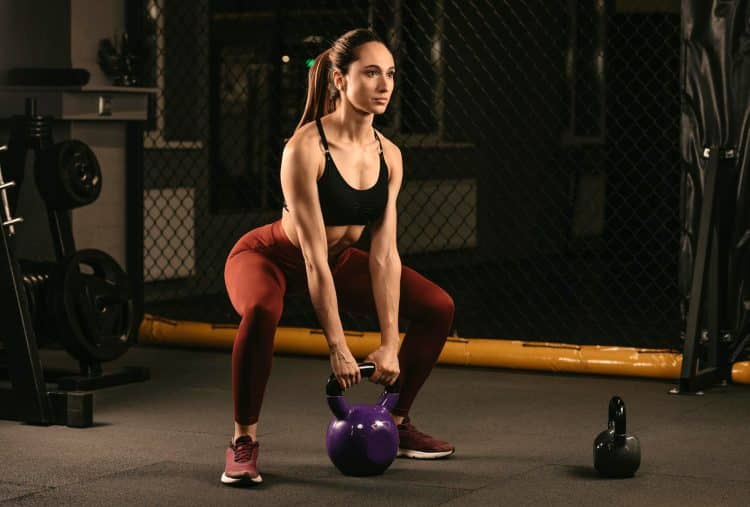With almost two decades of experience lifting weights and coaching others, I can confidently say that most people can never get healthy and fit because they struggle to find time to hit the gym.
Plus, basic at-home bodyweight workouts don’t cut it for most people, and gym equipment like dumbbells, barbells, weight plates, and treadmills can burn a hole in the wallet.
Expensive training gear shouldn’t hold you back from beginning your fitness journey.
The kettlebell is an incredibly versatile and cost-effective training tool that allows you to train your whole body and improve strength, cardio, and flexibility. (1)(2)
In this article, I reveal the four best kettlebell exercises for a complete body transformation and three different workouts for lifters of varying experience levels. These workouts will hit every major muscle group, giving you a full-body workout in a fraction of the time of a traditional gym workout.
4 Best Kettlebell Exercises For Full-Body Transformation
In kettlebell training, you train your body to move as a unit, which helps build functional strength. Here are the four exercises you must add to your regime:
Level Up Your Fitness: Join our 💪 strong community in Fitness Volt Newsletter. Get daily inspiration, expert-backed workouts, nutrition tips, the latest in strength sports, and the support you need to reach your goals. Subscribe for free!
1. Kettlebell Goblet Squat
| Sets & Reps | 3 x 8-12 (Hypertrophy) or 4 x 4-6 (Strength) |
| Equipment Needed | Kettlebell or Dumbbell |
| Target Muscles | Quadriceps, glutes, adductors, core |
As a personal trainer, the kettlebell squat is one of my go-to to help my clients build a strong foundation. The upright torso position also helps eliminate lower back strain.
Steps:
- Use an upright stance and hold the kettlebell close to your chest.
- Keeping your chest proud, flex your knees and hips to lower into a squat.
- Go as low as your mobility allows.
- Explode back to the starting position.
Pro Tip: Drive through your heels on the lifting phase to load the quads optimally.
| Difficulty | Beginner |
| Progression | Front barbell squat, barbell back squat |
| Regression | Bodyweight squat, box squat |
2. Kettlebell Row
| Sets & Reps | 3 x 8-12 per side (Hypertrophy) or 4 x 5-8 per side (Strength) |
| Equipment Needed | Kettlebell |
| Target Muscles | Latissimus dorsi, rhomboids, biceps brachii, posterior deltoids |
The kettlebell row is an incredibly effective exercise for fixing your upper body posture, as it strengthens your back and shoulders. You can pick between single-arm and bilateral kettlebell row variations depending on your experience level.
Steps:
- Hinge at your hips and place one hand on a bench or sturdy object for support.
- Hold the kettlebell in the other hand with a neutral grip.
- Pull the kettlebell toward your hip while driving through the elbow.
- Pause and contract the lat in the fully shortened position.
Pro Tip: Engage your core throughout the exercise and pull the kettlebell toward your hips rather than straight up.
| Difficulty | Intermediate |
| Progression | Single-arm row, dumbbell row, barbell row |
| Regression | Bodyweight inverted row, TRX row |
3. Kettlebell Swing
| Sets & Reps | 3 x 10-15 (Hypertrophy) or 5 x 5-8 (Strength) |
| Equipment Needed | Kettlebell |
| Target Muscles | Glutes, hamstrings, erector spinae, core, shoulders (trapezius) |
Imagine moving like a pendulum for this exercise. The explosive hip hinge motion involved in this exercise targets the posterior chain, improving overall aesthetics and athletic performance and reducing the risk of lower back pain.
Steps:
- Stand with your feet slightly wider than shoulder-width apart while holding a kettlebell by the horns with both hands between your legs.
- Push your hips back and swing the kettlebell between your legs while maintaining straight arms.
- Explosively drive your hips forward while squeezing your glutes for maximal power output and propelling the kettlebell upward.
- Your arms should be at least parallel to the floor at the movement’s top.
- Repeat for recommended reps.
Pro Tip: Keep your back flat, drive through your hips, and let the kettlebell do the work. Don’t lift it with your arms!
| Difficulty | Intermediate |
| Progression | Increase weight, increase reps, single-arm swing |
| Regression | Russian kettlebell swing (less hip hinge) |
4. Turkish Get-Up
| Sets & Reps | 2-3 x 1-3 per side (Hypertrophy and Strength) |
| Equipment Needed | Kettlebell |
| Target Muscles | Full body, particularly core, shoulders, triceps |
This is arguably the most complex kettlebell exercise of all time. It involves transitioning from lying on your back to a standing position while holding a kettlebell overhead. You must try it for yourself to experience the challenge. However, it is an excellent exercise for improving coordination, core strength, and shoulder stability.
Steps:
- Lie supine on the floor with a kettlebell in one hand and arm fully extended.
- Bend the knee on the same side as the kettlebell, and place the opposite arm out at 45 degrees.
- Engage your core and roll up onto your forearms, keeping your eyes on the kettlebell.
- Push through your foot and hand to lift your hips off the ground.
- Sweep your straight leg under the body and place your knee behind your hand. This should put you in a half-kneeling position.
- Drive through your front leg and stand upright, keeping the kettlebell overhead.
- Reverse the steps to return to the starting position.
- Repeat for the recommended reps before switching sides.
Pro Tip: This is an advanced exercise, and you should take your time mastering the movement mechanics before trying to lift too heavy.
| Difficulty | Advanced |
| Progression | Increase weight |
| Regression | Lying windmill, side plank with reach |
Kettlebell Workout Plans for Every Experience Level
Kettlebells are like the Swiss Army knife of the gym, as this equipment can help you transform your entire body with a multitude of exercises. However, you must pick the right program to maximize results.
Whether you are a beginner or a seasoned lifter, this section has tailored workout plans to help you reach your fitness goals.
Before we get into the workouts, here are the key training principles you must internalize:
- Master the Form: A sloppy form increases injury risk and can keep you out of action for several weeks if not months.
- Listen To Your Body: Discontinue an exercise if you experience pain or extreme discomfort. Learn to distinguish between pain and soreness.
- Progressive Overload: Always increase the weights, sets, and reps gradually to allow your body enough time to adapt.
- Rest and Recover: Give your body enough time to rest and recuperate. Going too hard too soon can lead to muscle and strength plateaus.
Kettlebell Workout for Beginners

As a beginner, you must focus on mastering the training form and building a solid cardiovascular and muscular strength and endurance base.
Level Up Your Fitness: Join our 💪 strong community in Fitness Volt Newsletter. Get daily inspiration, expert-backed workouts, nutrition tips, the latest in strength sports, and the support you need to reach your goals. Subscribe for free!
Since I don’t like leaving anything up to chance, here are a few programming tips:
- Frequency: 2-3 workouts per week (with a rest day in between)
- Equipment: Single kettlebell (women: 8-12 kilograms, men: 12-16 kilograms)
| Exercise | Sets | Reps | Rest |
| Goblet Squat | 3 | 10-12 | 60 seconds |
| Kettlebell Swing | 3 | 15-20 | 60 seconds |
| One-Arm Row | 3 | 8-10 (each side) | 60 seconds |
| Overhead Press | 3 | 8-10 (each side) | 60 seconds |
| Russian Twist | 3 | 15-20 (each side) | 60 seconds |
Coach Tips For Beginners:
- Use a mirror to check your form or record yourself.
- Always start with the lightest weight possible.
- If possible, hire a personal trainer.
- Rest for as long as you need between sets.
Kettlebell Workout for Intermediate Lifters
As you gain more experience, you must prioritize increasing training intensity and adding variations for a greater challenge.
- Frequency: 3-4 workouts per week (on alternating days)
- Equipment: Two kettlebells (gradually increasing weight)
| Exercise | Sets | Reps | Rest |
| Double Kettlebell Swing | 4 | 15-20 | 60 seconds |
| Goblet Squat | 4 | 12-15 | 60 seconds |
| Clean and Press | 4 | 6-8 (each side) | 60 seconds |
| Turkish Get-Up | 3 | 3-5 (each side) | 90 seconds |
| Windmill | 3 | 6-8 (each side) | 60 seconds |
Coach Tips For Intermediate Trainers:
- Start with a weight that allows you to perform the recommended reps with a picture-perfect form.
- Train to mechanical failure on the last set of each exercise.
- Prioritize a full ROM.
Kettlebell Workout for Seasoned Athletes
This is where you go full-send. Use challenging weights without compromising form to maximize muscle growth and power development.
- Frequency: 4-5 workouts per week, structured in a split routine (e.g., upper/lower body)
- Equipment: Multiple kettlebells, varying weights
| Exercise | Sets | Reps | Rest |
| Snatch | 5 | 6-8 (each side) | 60 seconds |
| Double Kettlebell Front Squat | 5 | 8-10 | 90 seconds |
| Kettlebell Pistol Squat (assisted if needed) | 4 | 5-8 (each leg) | 60 seconds |
| Kettlebell Swing Catch and Release | 4 | 10-12 | 60 seconds |
| Renegade Row | 4 | 8-10 (each side) | 60 seconds |
Coach Tips For Advanced Lifters:
- Advanced routines should ideally be highly individualized. Work with a personal trainer to devise a program that fits your training objectives.
- Incorporate unilateral exercise to identify and iron out strength and muscle imbalances.
- Try as many advanced kettlebell exercises as you can find.
Benefits of Kettlebell Training

I absolutely adore kettlebell exercises. Why is that, you ask?
Besides their cardiovascular and muscular strength and endurance-building benefits, the dynamic nature of kettlebell movements helps loosen tight joints, improving your mobility and range of motion (ROM).
“Kettlebells, unlike dumbbells, have an offset load which forces you to engage your core more to maintain proper technique, which can improve your form in other exercises as well,” adds coach John Wolf, American Kettlebell Club Coach.
Since kettlebell training involves dynamic movements, it helps boost your core strength. These cannonballs also usually have thicker handles compared to dumbbells or barbells, which increase grip strength and endurance.
Exercises like kettlebell swings and Turkish get-ups are full-body movements that burn a lot of calories in a short period. These exercises work large muscle groups through a wide ROM, ensuring maximal muscle fiber stimulation in a short time.
Finally, kettlebells are also easier to store and transport than dumbbells and barbells, making them an ideal pick for home gym owners.
The “Gym Replacement” Argument
Most people believe you need a gym membership to make any meaningful fitness progress. But is that true? Let’s examine this belief.
Your muscles can’t differentiate a kettlebell from a dumbbell or barbell; all they know is resistance. For a full-body transformation, you must work every major muscle group in your body that covers every movement pattern.
Here are the five movement patterns that your body needs and their benefits:
- Squat: Leg and glute development (Goblet squat and kettlebell swing)
- Hinge: Hip and back power (Kettlebell swing)
- Push: Chest, shoulder, and tricep strength (Kettlebell swing and Turkish get-up)
- Pull: Back, bicep, and grip strength (Kettlebell Row)
- Rotation: Core strength and stability (Turkish get-up)
As you can see, these four exercises hit all five patterns, ensuring a balanced workout and overall development. Plus, the three workouts listed in this article also include a few additional exercises that will help you get the best bang for your buck.
So, should you ditch the gym?
Well, I’ll leave that decision up to you. But by now, you might have realized that constantly varying your kettlebell workouts and employing progressive overload is all you need to transform your physique and keep making consistent progress.
Conclusion
If you have a packed schedule and are tired of jumping between different machines at the gym, these four exercises work your legs, core, back, shoulders, and arms — all in one go. The three workouts listed above ensure overall development by elevating your heart rate, burning fat, and building lean muscle mass.
I highly recommend adopting these kettlebell workouts, either as a standalone training program or as a supplement to your current regime. Stick to it for at least eight weeks, and the results will speak for themselves.
If you have any questions about the four kettlebell exercises or the workouts mentioned above, drop them in the comments below, and I’ll be happy to help!
References
- Lake, J. P., & Lauder, M. A. (2012). Kettlebell swing training improves maximal and explosive strength. Journal of strength and conditioning research, 26(8), 2228–2233. https://doi.org/10.1519/JSC.0b013e31825c2c9b
- Falatic, J. A., Plato, P. A., Holder, C., Finch, D., Han, K., & Cisar, C. J. (2015). Effects of Kettlebell Training on Aerobic Capacity. Journal of strength and conditioning research, 29(7), 1943–1947. https://doi.org/10.1519/JSC.0000000000000845








